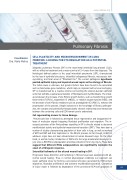Page 41 - MemoriaES-Eng
P. 41
www.ciberes.org
í
Pulmonary Fibrosis
CELL PLASTICITY AND MICROENVIRONMENT IN LUNG
Coordinator
FIBROSIS: LOOKING FOR ITS REGULATION AS A POTENTIAL
Dra. Mara Molina
TREATMENT
Idiopathic pulmonary Fibrosis (IPF) is the most lethal interstitial lung disease (ILD),
with no effective treatment and a mean survival of 2-4 years from the diagnosis. The
histological defined pattern is the usual interstitial pneumonia (UIP), characterized
by the loss of epithelial structures, interstitial collagenized fibrosis, microscopic hon-
eycombing, and focal areas of “fibroblast foci”. The current pathogenic hypothesis
posited epithelial injury and impaired wound repair as the etiology of fibrosis.
The initial cause is unknown, but genetic factors have been found to be associated
such as telomerase gene mutations, which imply an impaired cell turnover and aging.
IPF is characterized by a reactive stroma surrounding the altered alveolar epithelial
units that exhibits a spatial accumulation of fibroblasts and myofibroblasts. The imbal-
ance between the increase of pro-fibrotic growth factors, such as transforming growth
factor beta1 (TGF-β1), angiotensin-II (ANGII), or reactive oxygen species (ROS), and
the decrease of anti-fibrotic mediators such as prostaglandin-E2 (PGE-2), enhance the
perpetuation of the process. Despite advances in the knowledge of fibrotic pathogen-
esis, the complex and potentially therapeutically relevant relationship and interactions
between the containing cells and ECM remain poorly understood.
Cell regenerating answer to tissue damage.
Pneumocyte loss is followed by attempted tissue regeneration and exaggerated re-
lease of molecular signals triggering fibroblast proliferation and migration. The in-
creased activation of the Wnt-pathway signalling in IPF is directly related to abnormal
myofibroblast activity and epithelial-mesenchymal transition (EMT). They have been a
number of studies characterising population of stem cells in lung, as well as markers
of EMT and MET and their implication in the fibrotic process. So far, though, LRSC’s of 13
whatever origin have not been characterized in human diseased lungs. On the other 20
T
hand, in animal model, introduction of MSCs into the lungs ameliorates bleomycin in- OR
P
jury since a BM-MSCs subpopulation provides protection from lung injury. These data RE
suggest that different MSCs subpopulations can significantly modulate the L
A
onset of a fibrogenic response.
NU
N
Interstitial hallmarks of the altered wound healing in IPF.
A
S /
Progressive tissue distortion and hardening in fibrosis have been associated with ab- E
normal wound healing. Thus, in normal physiological conditions our organism can ER
B
repair epithelial injury by forming a provisional structure generated by ECM protein CI
deposition, fibroblast proliferation and transient myofibroblast activation. Completion
of injury repair is followed by degradation of the provisional ECM and apoptosis of
41


